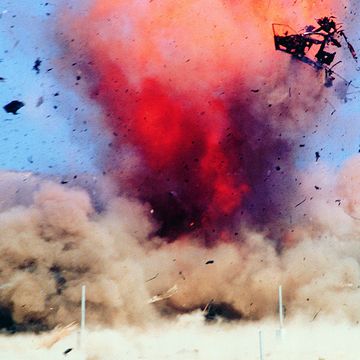One of the most abundant elements in the universe is getting harder to come by.
Helium goes into a lot more than balloons. Because the gas is inert and has extreme melting and boiling points—both near absolute zero—scientists use it in cryogenics, high-energy accelerators, arc welding, and silicon wafer manufacturing. A severe reduction in the availability of helium could force hospitals to replace costly MRI magnets or restrict patient access to them.
The federal government, which sets helium prices, announced in April that helium prices would spike from $75.75 per thousand cubic feet (Mcf) in FY 2012 to $84 per Mcf in FY 2013. (Last year, prices rose only 75 cents.) This price spike, along with uncertain federal policy (and a peculiar industry setup to begin with), is threatening to create a shortage. Here's what's going on.
Helium Hotspot
Although helium is the second most abundant element in the universe, most of it in the Earth's atmosphere bleeds off into space. Helium used for industrial purposes is a byproduct of natural gas production, and the Texas Panhandle is the United States' helium capital. In the natural gas fields near Amarillo, the U.S. government maintains the country's largest helium storehouse. The government put it there back in 1925 because natural gas produced at the gas fields between Amarillo and Hugoton, Kan., has a very high helium concentration—up to 1.9 percent.
Although other countries produce helium, the natural gas fields elsewhere around the globe are much less helium-rich than those near Amarillo. Because helium was critical to military reconnaissance and space exploration in the mid-20th Century, Congress mandated that the government encourage private helium producers nationwide to sell their helium to the government and store it near Amarillo as part of the Federal Helium Program.
Today, the U.S. alone produces 75 percent of the world's helium. Nearly half of that total, or roughly 30 percent of the world's helium supply, comes from the U.S. Federal Helium Reserve. That reserve is held in a huge natural underground reservoir near Amarillo called the Bush Dome. The dome is connected to a pipeline that links the stored helium with nearby helium refining facilities and the natural gas fields in Kansas.
Yet the American reserve is in danger. Between 10 and 12 billion cubic feet of recoverable helium are expected to remain in the reservoir by the end of 2014, Walter Nelson, director of helium sourcing for Air Products and Chemicals, Inc., told the U.S. Senate Energy and Natural Resources Committee in May. "At current production rates of about 2 billion cubic feet per year, the reservoir could continue to produce helium for five to six more years." But, he said, the computer modeling that predicts the amount of helium the reservoir will be able to produce, considering its complex geology, has determined that the reservoir production rates "will decline to approximately 1 billion cubic feet per year after 2014," he said. "As a result, the usable life of the reservoir will be extended to 2018 or perhaps even 2020."
And because of politics, the reserve may not make it even that far.
A Government-Mandated Shortage?
Where Congress once mandated that the federal government keep a reserve of this crucial gas, it reversed course several decades later. In 1996, Congress moved to privatize the federal helium program, requiring all of the government's helium supplies to be sold off by 2015. "The legislation in 1996 says we were supposed to get out of the helium business," says Joe Peterson, the Bureau of Land Management's assistant field manager for helium in Amarillo. "The hope was by 2015, by the time the reserve was sold down, that new sources of helium would be online and take up the demand. However, it has not happened yet."
Though new private helium production plants are set to come online in the coming years—including a Wyoming plant expected to open later this year—private industry hasn't been as interested in producing helium as Congress hoped. Until more companies begin producing helium on their own, consumers are left with spiking prices and tightening supplies.
Under the federal system, those prices are unstable partly because they have less to do with supply and demand than they do about the need for the government, under the U.S. Bureau of Land Management, to pay off the cost of creating the Federal Helium Reserve, according to David Joyner, president of Air Liquide Helium America, who testified before the Senate Energy and Natural Resources Committee in May. Helium prices were set by the BLM based on the amount of the remaining $1 billion debt the government incurred after it purchased its helium stockpile in 1960 and how much of that reserve was left.
"Because the original base pricing of federal helium started at below market levels, the BLM, at the recommendation of the National Academy of Sciences, is now making unpredictable increases to adjust for the base pricing up to market levels and to incorporate additional fees for costs that are specific only to the operation of the BLM reserve," he told the committee. This irregular pricing, he said, "drives up the price of helium for all consumers, not only here in the United States, but also around the world whenever the BLM crude price is adjusted."
When Helium Dries Up
As helium reserves tighten, the greatest impact could be on healthcare and small-scale scientific research. For example, a shortage could restrict the ability to obtain an MRI, too, if scanners become difficult to maintain with little helium to be found.
"Helium is absolutely essential to MRI production," says Tom Rauch, global sourcing manager for GE Healthcare, one of the largest manufacturers of MRI systems. The most important component of an MRI system is a large magnet containing superconducting wire cooled to 4.2 Kelvin, or minus 452 F. "Helium is currently the only element on Earth that can effectively keep the magnet this cold and consequently allow for the high field strength, stable and uniform magnetic fields that make modern MRI systems possible," he says.
And, he says, though companies like GE are trying to conserve as much helium as possible during the manufacturing process, MRI machines need a lot it: up to 10,000 liters of helium, with up to 2000 liters remaining in a sealed vacuum system around the magnet.
"If the supply constraint on helium continues unabated, it could be very harmful to patient care," he says. "If there were no helium to properly service an MRI, a 'quench,' or sudden boil-off could occur. While there is no immediate patient safety risk, a magnet could sustain permanent damage and may need to be replaced—an expensive and time-consuming process."
Other scientific fields might not require such a volume of the gas. But, according to Moses Chan, a Penn State University physics professor and member of a National Research Council committee studying the impact of selling the helium reserve, the grants that fund those researchers don't account for volatile price swings.
A Way Out?
Getting the government out of the helium business completely isn't possible yet, Nelson said, because private industry's response to the required government sell-off has been too slow and the geology of the helium reservoir near Amarillo is too complex to simply sell off the helium stored inside and then close its doors. "If the valve was simply left wide open to deplete the entire supply at once, valuable helium would be stranded in the ground and never recovered," he said.
The U.S. Senate is considering a bill called the Helium Stewardship Act of 2012. It would extend the 2015 deadline for the sell-off of the Federal Helium Program and allow the federal government to continue supplying world markets with helium, selling it at market prices instead of government-set prices. Nelson testified on behalf of the bill, saying that if it's not passed, the funding mechanism for the BLM's helium operations will expire, leaving researchers and MRI manufacturers in the cold by the end of next year. But Congress has taken no action on the bill since its introduction in April.













